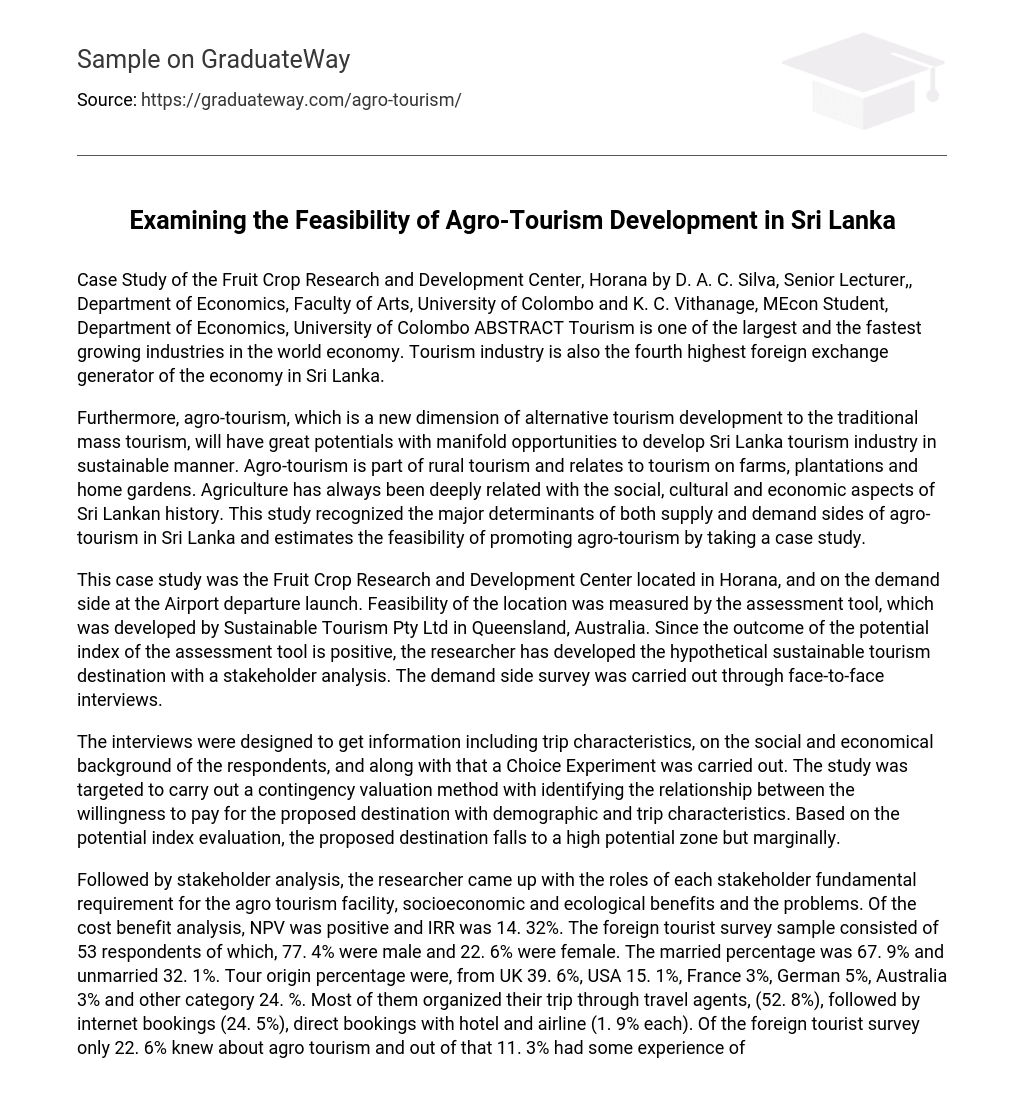Tourism is a vital component of the worldwide economy, growing rapidly and serving as the fourth largest contributor to Sri Lanka’s foreign exchange.
The study focuses on the potential of agro-tourism in Sri Lanka to contribute to sustainable tourism growth and create new opportunities. Agro-tourism, which falls under the category of rural tourism, involves experiencing farms, plantations, and home gardens. Given the historical significance of agriculture in Sri Lanka, it is deeply connected to social, cultural, and economic factors. The research investigates the various factors that affect both the supply and demand for agro-tourism in Sri Lanka and evaluates its feasibility using a case study.
The Fruit Crop Research and Development Center in Horana was used as a case study. The assessment tool, created by Sustainable Tourism Pty Ltd in Queensland, Australia, was used to measure the feasibility of the location. The assessment tool showed positive potential for the location, leading the researcher to develop a hypothetical sustainable tourism destination with a stakeholder analysis. Face-to-face interviews were conducted to gather data from the demand side.
The purpose of the interviews was to gather information on trip characteristics and the social and economical background of the respondents. Additionally, a Choice Experiment was conducted. The study aimed to utilize a contingency valuation method in order to determine the relationship between willingness to pay for the suggested destination and demographic and trip characteristics. According to the evaluation of the potential index, the proposed destination is classified as having high potential, although it is only marginally so.
Following stakeholder analysis, the researcher identified crucial requirements, socioeconomic and ecological benefits, as well as issues related to the agro tourism facility. The cost benefit analysis demonstrated a positive Net Present Value (NPV) and an Internal Rate of Return (IRR) of 14.32%. Surveying foreign tourists involved a sample of 53 respondents, with males representing 77.4% and females representing 22.6%. Among the respondents, 67.9% were married while 32.1% were unmarried. In terms of tour origin, individuals from the UK accounted for 39.6%, those from the USA comprised 15.1%, France contributed to 3%, Germany represented 5%, Australia stood at 3%, and others made up for24%.
The text reveals that 52.8% of tourists utilized travel agents to plan their trips, with 24.5% opting for online booking and 1.9% directly booking with hotels and airlines. Among the surveyed foreign tourists, only 22.6% were familiar with agro tourism, and within this group, 11.3% had prior experiences in this area. Merely 3.8% learned about agro tourism facilities in Sri Lanka from their tour operators or guides.
To sum up, the suggested destination is considered to have “high potential,” albeit marginally so.
Stakeholder analysis suggests that marketing promotions are necessary for the success of agro tourism development in Sri Lanka, both locally and internationally. Additionally, a cost benefit analysis indicates long term economic viability for agro tourism in the country. Furthermore, there were notable associations between willingness to pay for the facility and factors such as age, nationality, familiarity with agro-tourism, experience, and education. Regression analysis confirms that there is a positive and significant relationship between willingness to pay and education/experience in agro tourism.
According to the choice model, the number of planned accommodation days was found to be the most significant factor. The highest implicit price was observed for accommodations lasting one to two days. The two most preferred packages were one to two days of accommodation in a star hotel, with a willingness to pay between $20 and $50. The second preference was one to two days of accommodation in a cottage, with a similar willingness to pay range. The profession of the tourist seemed to influence the choice of the most preferred package.
With its diverse geophysics and climate, Sri Lanka is an ideal location for the development and expansion of agro-tourism. The country’s agricultural products, rural traditions, and agriculture-related festivals also contribute to this potential. Given the rising global demand for agro-tourism, investing in this industry in Sri Lanka can be advantageous. However, it is crucial to address the lack of awareness among farming and agricultural communities in order to fully exploit the opportunities presented by agro-tourism.
The government should offer the most advantageous financial aid to agro-tourism ventures in Sri Lanka via grants and institutional financing. Banks should also provide optimal financial support to these ventures. However, it is crucial to recognize that the correlation analysis employed in this research does not establish causation. Moreover, as the suggested destination was hypothetically presented to tourists, there might be discrepancies in terms of willingness to pay (WTP), attitudes, and perceptions.





